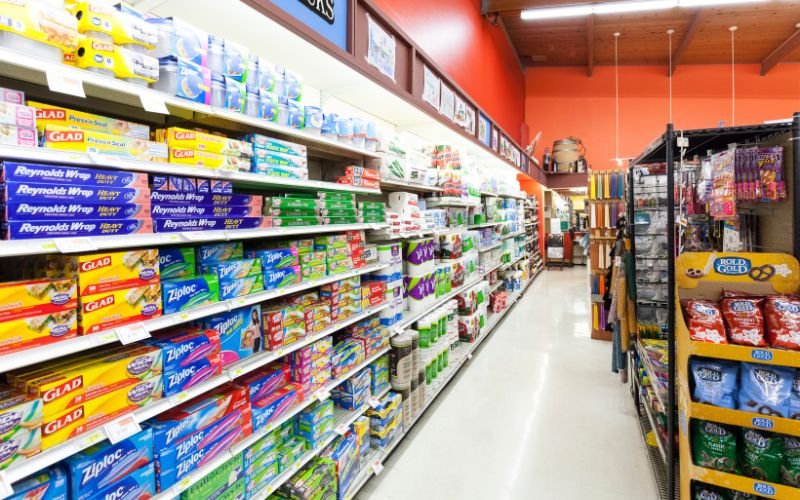1. Introduction & Core Concepts
Selling to grocery stores can open new doors for small food producers. Getting your products on store shelves takes careful planning, market research, and a strong understanding of retail partnerships that can last for years.
Making it in grocery stores means your product needs to stand out. Hundreds of new items come across buyers’ desks every week, so having permits, certifications, and retail-ready packaging is essential to move forward fast.
Getting into stores can transform your brand overnight. Success requires understanding store requirements, preparing data-backed pitches, and being ready to scale up quickly when orders start rolling in.
Keys to Success
Smart producers take time to research their target stores. They know that different chains have different needs, so they customize their approach for each one.
Breaking into grocery takes detailed planning and strong follow-up. When done right, you can turn a single order into an ongoing partnership that helps your brand grow month after month.
Building relationships with buyers requires clear communication about what makes your product special. Store shelves are packed with options, so focus on explaining why customers will choose your items over others.
You need quality products and consistent production to succeed. Grocery partners want suppliers they can count on for regular deliveries without any hiccups or delays.
This guide shows you proven steps to get your products into grocery stores. From research to pitching to scaling up, you’ll learn insider tips that have helped many brands find retail success.
.jpg)
2. Market Research, Permits, and Preparation
You need to do your homework before trying to sell to grocery stores. Preparing thoroughly will help ensure you succeed in this competitive market, where many businesses fail because they rush in unprepared.
Essential Steps for Success
Getting the right permits is your first critical task. Each area has different rules about health, safety, and how products should be packaged, so check with your local health department and agriculture office before doing anything else.
Market research is essential to understand who will buy your product. Look at store trends, what customers are buying, and how sales change with the seasons – this information will help you make smart decisions.
Your product needs to stand out from others on the shelf. If you’re selling something special like organic or gluten-free items, make sure enough people want to buy it in your target areas.
Understanding grocery buyers will make or break your success. Study their needs, ordering habits, and seasonal plans carefully so you can present your product effectively. You can find helpful tips about working with buyers at Selling To Supermarkets.
| Step | Description |
|---|---|
| 1. Regulatory Compliance | Obtain local permits and certifications (health, safety, labeling) |
| 2. Target Market Analysis | Identify consumer demographics and buying habits; analyze competitor products |
| 3. Product Differentiation | Clarify your unique selling points based on consumer trends and competitor gaps |
| 4. Buyer Requirement Research | Establish a list of potential grocery buyers; understand their specific standards and terms |
| 5. Packaging & Labeling Review | Ensure your packaging meets retail display standards and regulatory guidelines |
| 6. Production & Supply Chain Prep | Verify that your supply chain can consistently meet grocery store volume and delivery schedules |
Following each step carefully is important. Your hard work in preparation will show buyers you’re serious about success and ready for business.
Make sure to create clear charts and lists for your presentations. Store buyers like seeing organized information that shows you’ve done your research and understand their needs.
Keep up with what’s happening in your local market. A strong foundation of research and preparation will give you the best chance at success in grocery store sales.
Crafting an Effective Sales Pitch
A strong sales pitch can make or break your success when selling to grocery stores. Your pitch needs to showcase what makes your product special and address what buyers care about, and this guide will help you create one that works. Following these proven steps will increase your chances of getting your products on store shelves and catching buyers’ attention.

Know Your Audience and Tailor Your Message
Grocery buyers look at hundreds of products every week, so your pitch must be short and clear. Research shows that focusing on what makes your product unique can make buyers 30% more interested. Your message should talk about things like how long your product lasts on shelves, how good it looks in stores, and proof that customers want to buy it.
Structure Your Pitch for Maximum Impact
Break down your pitch into these key parts:
- Introduction:
Start with a quick overview of your company and what your product does. Make a short statement about why your product fits what shoppers want today, especially if it’s healthy or locally made. - Product Differences:
Tell them what makes your product better than others. Mention specific facts like “Our product stays fresh 20% longer than similar items.” - Proof It Works:
Share real numbers from your sales history. Talk about things like how many customers buy your product again or what store owners say about it. - Handle Concerns:
Answer questions before they ask them, like how you’ll get products to stores and what prices will be. Tell them how you’ll help sell the product through marketing and demos. - Next Steps:
End by telling them exactly what you want to happen next, like setting up a meeting or sending samples.
Make It Look Professional
Keep your words simple but sound like you know what you’re talking about. Grocery buyers like working with people who are smart but easy to talk to. Use pictures and charts to show important information, as these can help convince buyers better than words alone.
When you follow these steps and include real facts and numbers, you’ll have a pitch that works. Remember that the best pitches feel personal and use real data to back up what you’re saying.
Navigating Regulations & Building Retailer Relationships
Meeting food safety standards is crucial for success. Working with grocery store buyers requires careful attention to every detail in your product packaging and labeling. The path to building lasting partnerships starts with following all the rules closely and keeping good records. This foundation helps you talk to buyers with more confidence.
Understanding Product Compliance
You must check that your labels follow both local and federal rules. Understanding ingredient lists and nutrition facts can take time, but it’s worth the effort to get everything right. Your product needs clear allergen warnings and proper barcodes to meet store requirements. Getting all permits and keeping organized files makes talks with buyers much smoother.
Once you handle the rules, you can focus on making deals. Every talk with a buyer should show how your product helps their store. Create a clear plan that uses real numbers to show why your product will sell well. Remember to be ready to talk about:
• What makes your product special • How you’ll keep stores supplied • When you can deliver • Ways you can help with marketing
Building trust takes time and needs regular contact. Quick responses to questions and regular updates help build strong connections. Face-to-face meetings can make working together easier and more successful. This helps both you and the store do better business.
Talks with buyers happen more than once. You need to keep working on the relationship and be ready to change when needed. Making plans for different seasons shows buyers you think ahead. What buyers tell you can help make your product better.
For more help with selling to stores, check out Food Marketing Tips. Their advice can improve how you talk to big stores.
Following rules carefully and building good relationships helps you succeed in grocery stores. This way of working keeps your products on shelves and makes stores want to work with you more.
Optimizing Packaging, Pricing, & Promotional Strategies
Good packaging, fair prices, and smart marketing help products succeed in stores. The right mix of these elements can turn a new product into a big hit, as shown by data from actual store tests that saw sales jump by 25-30% after making these improvements.
Packaging Design & Execution
Your product needs to catch eyes and build trust in stores. A recent study found that 65% of shoppers prefer brands with earth-friendly packaging. Labels should be easy to read and include all the important facts about nutrition and safety that customers need. You should follow a standard layout for all your packages – see Table 1 for a good example.
| Component | Requirement | Consumer Impact |
|---|---|---|
| Front Panel | Product name; key benefit tagline | 40% of purchase decision |
| Side Panels | Nutritional facts; certification logos | Enhances credibility |
| Back Panel | Detailed ingredients; usage tips | Improves customer experience |
Pricing Strategies
Know your costs before setting prices. Recent data shows that finding the right price point can boost new store sales by 15%. Look at what similar products cost in stores where you want to sell. Short-term deals like new product discounts or bundle offers have helped new brands increase repeat purchases by 20%.
Promotional Tactics
In-store demos and displays can boost trial rates by over 30%. Working with stores on special promotions can make your product 35% more visible to shoppers. Use social media and email to support your in-store efforts – this keeps customers thinking about your product and coming back for more.
Your success in stores depends on how well these pieces work together. Keep track of what works and make changes based on sales data and customer feedback.
6. Post-Sale Strategies & Sustaining Success
After your products get on store shelves, there’s still much work to do. Staying successful in grocery stores takes constant attention to detail and smart planning. Your long-term growth depends on building good relationships with stores and making changes based on data.
Essential Follow-up Steps
A solid follow-up plan helps you keep your current store partners happy. Regular meetings with buyers let you track how well your products are doing and fix any problems quickly. Your main goal should be finding and solving issues before they become big problems.
Here’s what to do after your products hit the shelves:
- [ ] Call stores two weeks after launch to see how things are going
- [ ] Write short reports about any feedback or shelf placement issues
- [ ] Create a plan for handling problems with quality or delivery
- [ ] Keep buyers updated with emails about sales trends
- [ ] Visit stores to check how products look on shelves
- [ ] Save email templates to make follow-up easier
Keep clear records of every store visit and conversation. A simple tracking system helps you remember important details and next steps. Here’s a basic way to track everything:
| Date | Contact Person | Feedback Summary | Action Required | Follow-up Date |
|---|---|---|---|---|
| 2023-09-15 | John Doe | Positive initial sales; need re-stock | Increase supply | 2023-10-01 |
| 2023-09-30 | Jane Smith | Minor packaging issues, campaign delay | Revisit packaging specs | 2023-10-10 |
Following up shows stores that you care about their success. Good relationships with grocery stores take time to build but are worth the effort. Make changes quickly when needed, and always look for ways to improve.
Your products will gain more trust from shoppers over time. Strong follow-up plans turn single store placements into lasting partnerships, which is key to selling more products in grocery stores.
FAQs
How long does it take to get a product into grocery stores?
The process typically takes 3-6 months, including preparation, pitch meetings, and final placement.
What permits do I need to sell products in grocery stores?
Required permits include food safety certifications, business licenses, and specific local health department approvals.
How do I price my products for grocery stores?
Calculate all costs, research competitor pricing, and aim for 40-50% profit margin after retailer markup.
What makes a successful grocery store pitch?
A successful pitch includes unique selling points, market data, production capacity proof, and clear pricing strategy.
How do I maintain relationships with grocery store buyers?
Regular communication, consistent product quality, reliable delivery, and proactive problem-solving are key.

.jpg)



